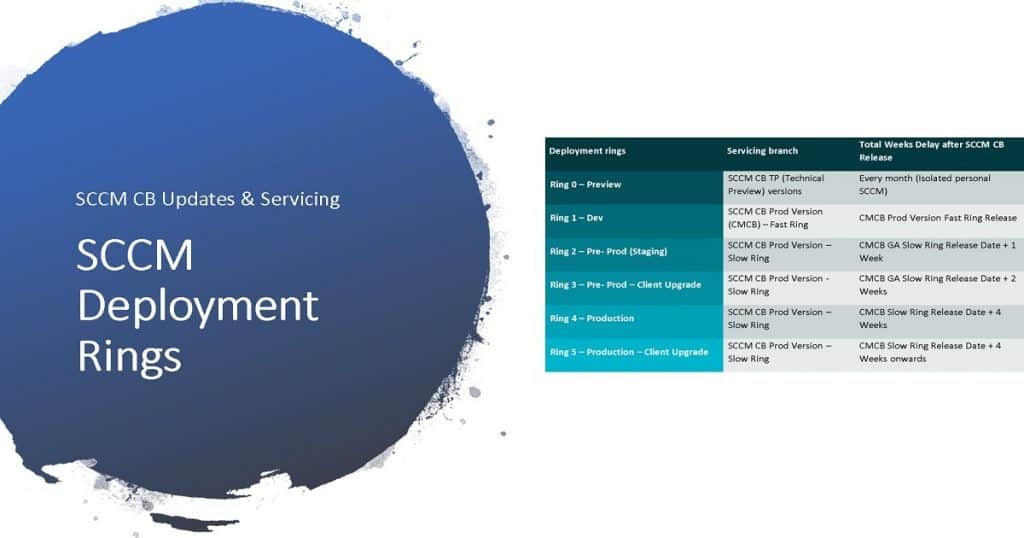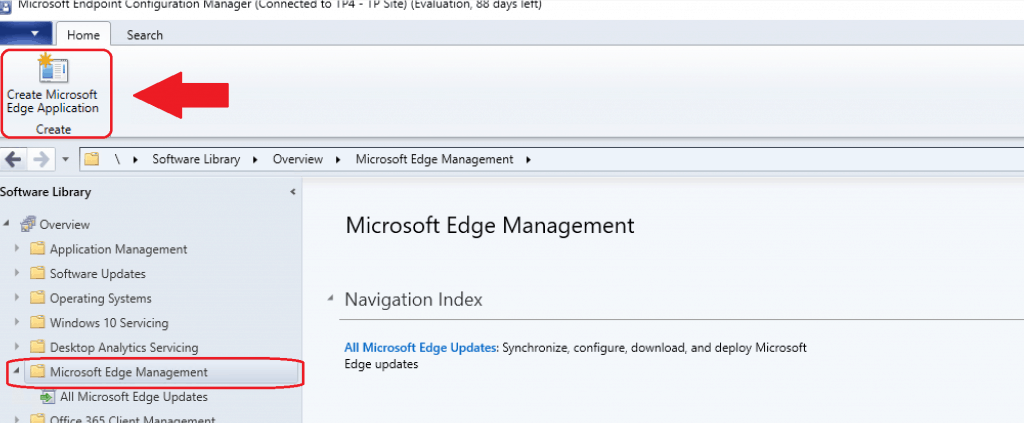Let’s discuss and walk through the new features of the SCCM 1910 (SCCM 1910 Features) production version. I have explained and shown most of these new features in the video tutorial.
SCCM 1910 = MECM 1910 (to know more read article ) Microsoft Endpoint Configuration Manager (MECM)
NOTE! – SCCM or MECM 1910 production version is NOT the baseline version! The latest SCCM CB baseline version is 1902.
Why Upgrade Configuration Manager ConfigMgr
Wow! Stay up to date! Stay Current! What?
Do you wantfull support (OSD?) for Windows 10 1909? Support Windows 10 as a client with SCCM 1910 version.- Do you want to have issues with SCCM 1906 (Refer to SCCM 1906 known issues list)? All these issues are fixed with ConfigMgr 1910
Prerequisite SCCM 1910 Production Version?
The SCCM 1910 production version released is in the Slow Ring. The MEMCM 1910 won’t be available automatically in your SCCM console. I shall update here once Microsoft releases the 1910 version broadly.
So, the 1910 production version will be available within the SCCM console after you run the PowerShell command and your SCCM site meet the following conditions:
If you want to get into SCCM 1910 FAST ring NOW – Run the PowerShell command(SCCM 1910 is Generally Available)- If your SCCM CB version is SCCM 1810 or SCCM 1902, or SCCM 1906 (Read More details about SCCM Life Cycle)
- If your SCCM CB version has an online Service Connection Point
Note – You don’t need to run the PowerShell script when Microsoft releases a SLOW ring version of SCCM 1906 at a later stage.


Time to Upgrade to SCCM 1910 (meh MECM 1910)?
Every organization might have its own SCCM CB infra update strategy. I have seen the organization decides to update SCCM after three (3) months of release. Some might wait for the first rollup update. It’s better to stick with your organizational practice for SCCM upgrades.
I have written a post to help build the SCCM infra update strategy. I would recommend reading the post and commenting on whether you agree with this approach or not — more Details SCCM Infra Upgrade strategy.

SCCM 1910 Upgrade Guide
I have already published a more detailed guide on MECM (Microsoft Endpoint Configuration Manager) or ConfigMgr 1910.
More details are available in “SCCM 1910 Update Step by Step Guide.”
Once the 1910 upgrade is completed successfully, you can have the following features enabled for the device management scenarios.
Bitlocker Management SCCM MBAM
At last, MBAM is part of the SCCM 1910 production version. MBAM shall help you to perform Bitlocker Management. The following are the high-level options available in the 1910 version — more details on Improvements to BitLocker management.
Setup
- Bitlocker Drive Encryption Settings
- Choose the Encryption and Cipher Strength – Enabled
- Select the Encryption method – AES 128-bit (default)
- Choose drive encryption and cipher strength (Windows 10) – Enabled
- Operating System Drives – AES-CBC 128-bit/265-bit
- Fixed Data Drives – XTS-AES 128-bit/256-bit
- Removable Drives – XTS-AES 128-bit/265 bit
- Choose the Encryption and Cipher Strength – Enabled
Operating System Drive
- OS Drive Management Settings
- Operating System Drive Encryption Settings – Enabled
- Allow Bitlocker without a compatible TPM (Requires a Password) – Allow
- Select Protector for Operating System Drive
- TPM Only
- TPM and PIN
- Configure minimum PIN length for startup – 4
Client Management
- Client Management Settings
- Configure Bitlocker Management Services – Enabled
- Select Bitlocker Recovery Information to store
- Recovery Password only
- Recovery Password and key package
- Enter client checking status frequency in (minutes) – 90
- Select Bitlocker Recovery Information to store
\Assets and Compliance\Overview\Endpoint Protection\BitLocker Management

Deploy Microsoft Edge Browser
With the 1910 version, you can deploy the New Microsoft Edge browser using Endpoint Manager SCCM.
SCCM team created an out of box experience to create an SCCM application for new edge browser (chromium-based) deployment (Deploy Microsoft Edge Browser).
I have a separate post explaining the end to end Microsoft Edge update process with MECM. More details “Deploy Microsoft Edge Browser with SCCM Endpoint Manager.”

Microsoft Connected Cache Options
Microsoft Connected Cache (MCC) service is an on-prem delivery optimization solution announced in Ignite 2019. You can use SCCM or MECM DP as it’s connected to the Cache content location. More details are available in “SCCM and Microsoft Connected Cache Integration to Help with Bandwidth Issues.”
- Server Side Config from – \Administration\Overview\Distribution Points
- Client Side MCC configuration from > \Administration\Overview\Client Settings

Application Groups – User Deployment
With the latest MECM (SCCM) version, you can create a group of applications and send that to a user or device collection as a single deployment.
You can also perform the sequencing of the apps in the group so that the SCCM client installs them in a specific order.
In 1910, you had the following improvements:
- Users can Uninstall the app group in Software Center.
- You can deploy an app group to a user collection.
Try this out ▶▶\Software Library\Overview\Application Management\Application Groups.

Copy Paste TS Condition
With the 1910 version of SCCM, you will get a new option to Copy and paste task sequence conditions. This option would be useful to reuse the requirements from one task sequence step to another.
You can now copy and paste conditions in the task sequence editor.
Try this out ▶▶\Software Library\Overview\Operating Systems\Task Sequences

1910 New Right Click Option Client Diagnostics
1910 version of SCCM introduced a new device action called Client Diagnostics. You can include the following steps:
- Enable verbose logging: Change the global log level for the CCM component to verbose, and enable debug logging.
- Disable verbose logging: Change the international log level to default, and disable debug logging.
- In the SCCM console, go to the Assets and Compliance workspace, select the Devices node, and choose a target device.
- In the ribbon, on the Home tab, in the Device group, select Client Diagnostics. Choose one of the available actions.
- Enable verbose logging
- Disable verbose logging
Track the status of the task client diagnostic task in the diagnostics.log on the client.
Try this out \Assets and Compliance\Overview\Device Collections

Teams Chat Option MECM 1910 Console Connections
With the Teams chat option, you will be able to chat with console users connected to the SCCM site instantly. Let me know how useful this feature is for SCCM admins. I don’t recommend installing teams on SCCM primary server to use this feature.
I think Teams chat options will be helpful for a scenario where all your admins use Windows 10 remote console. View active consoles and message administrators through Console Connections.
Try this out from \Administration\Overview\Security\Console Connections.

Management Insights Health Checks
I don’t see many enhancements in the 1910 version of SCCM/MECM! For more details, “SCCM Management Insights – Healthy SCCM Infra.”
SCCM Management Insights will help you gain valuable insights into the current state of the SCCM environment. The Management insights are based on analyzing data in the site database.
Try this out from \Administration\Overview\Management Insights\All Insights.

WVD Support Enhancements
With the 1910 version, you can see options to enable the user policy for Windows 10 multi-session concurrent users. Intune support for this scenario is not announced.
I have a details post about SCCM support for WVD and Intune support for WVD. More details are available in “WVD Windows 10 Multi-Session Intune Hybrid Azure AD Support.”
- Client Settings
- Client Policy
- Enable user policy for multiple user sessions –> YES
- Client Policy

Custom Compliance Policies
SCCM is a bit ahead of Intune here 😍 Here is the option to create custom compliance policies from SCCM. Does your organization have a special requirement to check a special condition on the device before providing access to corp resources?
This option to have a custom compliance policy will help you. You can try this out from:
- \Assets and Compliance\Overview\Compliance Settings\Compliance Policies
- Add Rules
- New Condition
- Include Configured baseline in compliance policy assessment ==> TRUE
- New Condition
- Add Rules

SCCM Real-Time Management?
CMPivot is the real-time management solution that the latest version of SCCM is equipped with! CMPivot architecture is explained in my previous blog post. More details “CMPivot Fast Channel Making SCCM Fast.”
With the 1910 version, Microsoft improved the performance of CMPivot without much impact on CPU workload. Microsoft claims that you can now collect gigabytes of client data in real-time with these optimizations.
For more details – https://docs.microsoft.com/en-us/sccm/core/servers/manage/cmpivot#bkmk_optimization
Other improvements with CMPivot 1910 version are:
- Windows event logs (WinEvent)
- File content (FileContent)
- DLLs loaded by processes (ProcessModule)
- Azure Active Directory information (AADStatus)
- Endpoint protection status (EPStatus)

Features didn’t make it to MECM 1910
- Orchestration Groups – New Server patching option introduced in 1907 technical preview version didn’t make to 1910/ More details available “SCCM Orchestration Group Setup Step by Step Guide for Server Patching.”
- The tenant Attach/Cloud Console feature, announced in Microsoft Ignite 2019, is not part of the latest preview version and production version 1910 of SCCM.
- Extend Migrate SCCM To Azure – The ExtendMigrateToAzure.exe tool helps to Extend or Migrate SCCM infra to Azure. This tool didn’t make it to MECM 1910 production version.
- Community Hub Updates are minimal in the production version. We will wait and see our plans and priorities for Community Hub from Microsoft. More information about ConfigMgr community hub is “SCCM Community Hub – Scripts Reports and Documentation.”

Resources – SCCM 1910 Features
- For known or significant issues of the SCCM 1910 production version, see https://docs.microsoft.com/en-us/configmgr/core/servers/deploy/install/release-notes
- What is New in SCCM 1910 – https://docs.microsoft.com/en-us/configmgr/core/plan-design/changes/whats-new-in-version-1910



Hello Anoop
Why do you say if we would like to have full support (OSD?) for Windows 10 1909, upgrade to CB1910.
CB1906 is not full compliant with windows 10 1909 ?
Thanks for your feedback
I think I will provide more clarification or remove that line ..because Windows 10 1909 release is different from other Windows 10 releases. The statement in the post is not valid for 1909.
Microsoft has done a great job with 1910 CM. Thank you for writing this up ! Endpoint management is going to be easy Now.
I have some issues with the teams chat part. What if you actually adopt the tiering model that (Microsoft also recommends) really should be followed if you have a infrastructure that requires MECM in the first place. What it implies is that you administer clients PCs with a client that is secure, preferably with a separate account and with secured access to internet. Is this really a good idea? It’s leading customers into a operational model which really isn’t recommended…
Can 1910 CM manage bitlocker to-go?